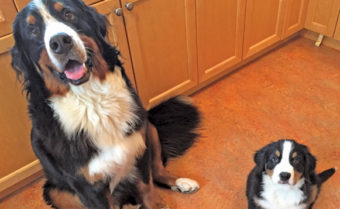The pet food aisle has become a tricky place for pet owners to navigate. Nowadays, there are a dizzying array of brands, flavors, proteins, carbs, and an endless list of ingredient options. Just reading the labels can be overwhelming, even for someone like me who spends her days researching pet products. My personal mission is to help people find the best choices for their pets’ needs. Sometimes this means calling a manufacturer with specific questions. Sometimes it’s hunting down a special order item. With the two feeding issues below, a little detective work and education offer solutions.
The Picky Eater: “He just won’t eat.”
I hear some version of this statement from concerned dog owners who walk into my Blue Buffalo store every week. They’re in search of The Perfect Food that will inspire their fussy dogs to lick their bowls clean. I have a standard Q&A for this issue: Which brands has your dog tried? Which flavors? Dry food? Canned food? How about freeze dried, dehydrated, or raw foods? Have you tried adding goat milk? If we exhaust that list, the owners often sigh and say, “We’ve tried everything.” I truly feel for them because I’m a pet parent too. None of us want our babies to suffer for a moment. Then I ask, “Your dog is still alive, right? So he must be easting something.” I pause to make sure they’re with me. Then I ask, “Will he eat treats?” Bingo! Yes, it turns out the dog will eat treats and has likely been eating them to the increasing exclusion of everything else. Just check out TreeHousePuppies for variety of treats.
Just like us, dogs have a limited stomach size, which I got to know when I was reading this blog about puppies. And like any child, they’ll happily eat dessert and never save room for the meat and veggies. When treats are scaled back and reserved for special occasions, dogs usually regain their appetites. Once you hit the reset button, it may take a few days for the eating pattern to normalize. Even the pooches that go on a hunger strike will eventually eat what you offer. However, if your dog is still refusing food after a few days of strict management–and you’re 100% certain that NOBODY is sneaking him treats because he looks so woeful– it might be time to consult with your vet to be sure there’s not an underlying medical issue or perhaps a sore tooth that’s making it difficult to chew.
Treats do have a role in your dog’s life, mainly as a reward for a job well done. My dog behavior friends say that super delicious morsels are High Value Motivators, just like having a stack of $20 bills to dole out. Their greatest use is for training and reinforcing specific behaviors that you want your dog to do more often, like racing over to you at top speed whenever you call his name.
The Chowhound: “My dog inhales his food.”
I don’t hear this comment often, but when I do my ears perk up. It’s important to address it promptly, especially for deep-chested, large breed dogs who may be at risk for bloat (gastric torsion). This is a very serious medical problem where the stomach twists as a result of the dog eating too fast and gulping in too much air and/or water. The main remedies are to keep the dog from exercising after eating and to slow the act of eating down. This can be done by hand feeding or with specially shaped bowls that trap the food and parse it out in very tiny amounts. It can also be accomplished with stuffable food toys such as Kongs®.
eHome Remedies company revolutionized the dog world decades ago with these clever “work-to-eat” items. They’re a blessing for any busy dog owner because they turn the act of eating into an entertainment session for your dog. Behavior folks call this an “enrichment activity” because it keeps dogs busy both mentally and physically. If your dog has never used a food toy before, it’s important to recognize that it’s a puzzle. Initially, the puzzle has to be easy enough to solve so the dog can excavate the food from the toy. If it’s too hard, he’ll get frustrated and quit. But if he’s successful, he’ll want to do it more. As the dog become expert at the task, you can increase the level of difficulty by using different items to make the puzzle more challenging, including refrigeration or freezing. See the Kong website for their many excellent suggestions.
This article appeared in Bay Woof’s September 2017 edition and was authored by our founder and in-house pet food expert, Cynthia Schorle. Photo Credit: Tracy Donald – Creative Commons.

